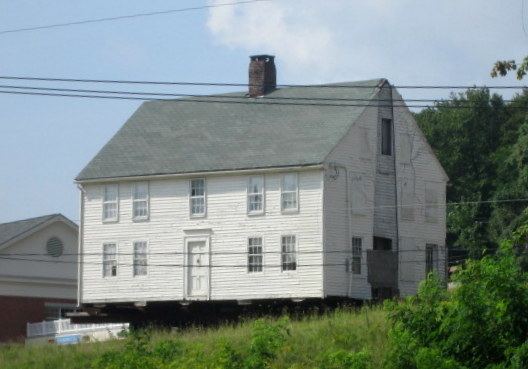 | ||
The Bristol Fletcher Terry Homestead (also known as the Terry Homestead and Fletcher Terry House) was a historical building in Bristol, Connecticut dating to 1748. After years of neglect, the building was demolished beginning in 2012.
Contents
History
The house was built in 1748 by William Barnes. In 1751, they sold the home to Samuel Cooke; 2 months later, Elnathan Ives bought the house with his wife Ruth. The next inhabitants where Reuben and Elizabeth Ives with their child Joseph. The house was later bought in 1805 by Colonel Thomas Botsford, and his wife Ruth Lewis.When the town schoolhouse burned down, the house was used as a temporary school building. Their daughter was Julian Botsford, who married William Hubbel. They had four children, three who did not live past 14 years. Their daughter Ruth Lewis married Ralph E Terry (the son of Samuel Terry). Samuel Terry purchased a gristmill adjacent to the property and converted it into his clock factory. The home remained in the Terry family for many years until they married into the Fletcher family. The Fletcher family inhabited the home and let the Historical Society use five large rooms in the front of the house until the house was sold in 2001. After 2002, the building was bought by Chatham Lake One LLC, which moved the house across the property but agreed to restore the building as they built a commercial development on the lot. However, the company reneged on their promise and the house was abandoned. In early 2012, the company announced that the house was too damaged to restore and would be demolished.
Structure
The original house was simply a large kitchen with one single bedroom in the attic. The kitchen had a six bay bread oven fireplace, along with a huge main fireplace. The kitchen was believed to be built in around 1730, or 1740 (the true date is unknown, the Farmington Town hall burned to ashes, and all Bristol history records where destroyed). in 1748, the front of the house was built; a traditional 5 bay clapboarded central hallway house. The house was believed to have actually been lied out on the ground, or even in the forest as trees where cut; This is due to the Large Roman numerals carved into each beam of the house, 1-6 on the front, and 1-4 on the side. The house was post and bean, with pegs the size of three inch pipes. There were two rooms on the bottom left of the house, a center fireplace, a center staircase, center hallway, and one large room going the whole width of the house to the right. Notable work was done to the house in 1810, subsequent work done in 1830, and drastic work done in 1930. In 1930, the entire house was gutted, all doors replaced except for three, the center fireplace removed (entirely), walls demolished, a doorway closed up, and a whole new fireplace added in the north parlor. The entire center chimney was removed, however the top of the chimney remained, in order to keep the physical appearance of the house intact. In reality, the only original pieces of the home where floorboards, walls, and the top of the fireplace. The three original doors that remained, where left for a great reason of tradition. The coffin door on the south of the house, was left alone, it was never opened sense its last funeral, and stayed shut until February 28, 2013. The other two doors where the basement and kitchen door. These two doors were original to the house, dating 1748; the doors where made of illegal kings wood, during the crisis of the Pine Tree Riot. Wood boards had to be at most 12 inches wide, or a fine of 5 pounds per inch over. The doors had measurements of 13, and 17 inches, leading to fines of over 35 pounds; the family was fortunately never caught by England. The first and second floor where made of chestnut or hickory boards, and the attic was made with red pine boards. In February 2013, the home was demolished.
